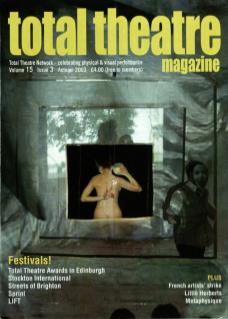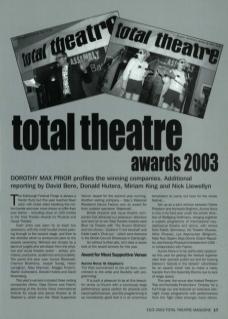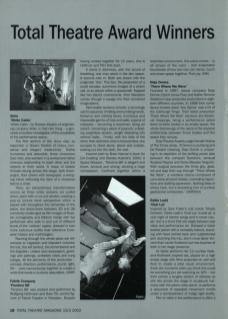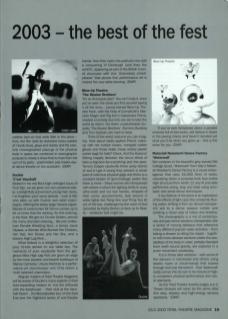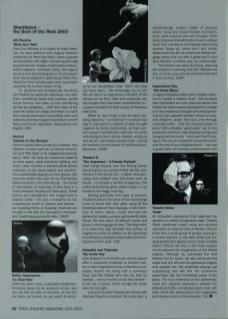The Edinburgh Festival Fringe is always a frantic flurry but this year reached fever pitch with ticket sales breaking the million barrier and even more shows on offer than ever before – including close on 200 entries to the Total Theatre Awards for Physical and Visual Theatre.
Each entry was seen by at least two assessors, with the most lauded shows passing through to the second stage, and then to the shortlist which is announced prior to the awards ceremony. Winners are chosen by a panel of judges who are drawn from the physical and visual theatre sector – artists, promoters, producers, academics and journalists. The panel this year was: Louise Blackwell Chenine Bhathena, Joseph Seelig, Helen Lanaghan, Mary Brennan, Maggie Kinloch, Martin Sutherland, Donald Hutera and David Rosenberg
This year's winners included three visiting companies (Akhe, Deja Donne and Fabrik) appearing at the Aurora Nova international festival for visual and dance theatre at St Stephen's, which won the ‘Most Supportive Venue' award for the second year running. Another visiting company – Italy's Materiali Resistenti Dance Factory won an award for their outdoor spectacle Waterwall.
British physical and visual theatre companies that attracted our assessors' attention and went on to win Total Theatre Awards were Blow Up Theatre with The Illusion Brothers and two shows – Duckie's C'est Vauxhall and Eddie Ladd's Club Luz – which were featured in the British Council Showcase in Edinburgh.
So without further ado, let's take a closer look at the award winners for this year.
2003 – The Best of the Fest
Award for Most Supportive Venue: Aurora Nova / St Stephen's
For their commitment to the artform, commitment to the artist and flexibility with programming.
It is such a pleasure to be at this beautiful venue (a church with a luxuriously large performance space perfect for physical and visual performance), and the programming is so consistently good that it is an enormous temptation to camp out here for the whole festival...
Set up as a joint venture between Fabrik Potsdam and Komedia Brighton, Aurora Nova is now in its third year under the artistic direction of Wolfgang Hoffmann, bringing together a superb programme of international visual/physical theatre and dance, with shows from Fabrik (Germany), Do Theatre (Russia), Akhe (Russia), Les Argonautes (Belgium), Nats Nus (Spain) Deja Donne (Czech Republic) and Gravity-Physical Entertainment (USA in collaboration with Fabrik).
Aurora Nova is to be particularly applauded this year for getting the festival together after their sponsor pulled out and for hosting Derevo's Islands in the Stream (shortlisted for an award) which had to make a hasty transfer from the Assembly Rooms due to lack of stage space.
This year, the venue also hosted Periplum Tree and Komedia Productions Crowley for a full Fringe run and featured an extensive late-night music programme with performances from the Tiger Lillies amongst many others.
Akhe, White Cabin
White Cabin, by Russian theatre-of-engineering company Akhe, is that rare thing – a genuinely innovative investigation of the possibilities of the performance space.
The first section of the show was, as expected, a 'dream theatre of chaos, nonsense and elegant melancholy’. Darkly humorous and absurdist, three characters (two men, one woman) in a surreal and rather ominous relationship to each other and the objects in their world. A mass of elastic threads strung across the stage, spilt champagne, floor strewn with newspaper, a swinging mirror reflecting the face of a character tied to a chair.
Then, an extraordinary transformation occurs as three white screens are pulled down, each with a cut-out window creating a pop-up picture book perspective which is played with throughout the remainder of the piece, the distinctions between 2D and 3D constantly challenged as film images of Russian iconography and folklore merge with live performers who walk in and out of different levels of the 'cartoon' space, dressed in ever more ludicrous outfits that reference European history and mythologies.
Running through the whole piece are references to migration and transient cultures: the lost, the left behind, the remembered and the forgotten. Letters and newspapers, greetings and partings, scribbled notes and sung eulogia. All the elements of the production – concept, direction, performance, sound, light, film – work harmoniously together to create a world that revels in its divine absurdities. (DMP)
Fabrik Company, Pandora 88
Pandora 88 was created and performed by Wolfgang Hoffmann and Sven Till, central figures of Fabrik Theatre in Potsdam. Despite having worked together for fifteen years, this is Hoffman and Till's first duet.
It starts in darkness, with the sound of breathing, one man alone in the dim space. A second rolls in. Both are drawn into the enigmatic 'box'. This box, the proportion of a small elevator, summons images of a prison cell, or an airlock within a spacecraft. Trapped like two playful cosmonauts, their liberation comes through a voyage into their combined imaginations.
Memorable sections include: a stunningly well lit sequence of falling and tumbling hands, forearms and orbiting faces; humorous and impossible games of hide and seek; a game of charades – becoming a snowman, being an ostrich, becoming a piece of popcorn; a floating weightless section, weight dissolving into vertical walls... Finally, with the help of the other, their restricted zone is transcended, one escapes to stand alone, above and outside, looking out into the dark, the void.
Inspired both by Brian Keenan's book An Evil Cradling and Stanley Kubrick's 2001: A Space Odyssey. Pandora 88 is elegant and brave, sensual and strong, eliciting a huge compassion. Confined together within a restricted environment, this piece moves – in all senses of the word – and evaporates boundaries of how two men can dance, touch and share space together. Pure joy. (MK)
Deja Donne, There Where We Were
Founded in 1997, dance company Deja Donne (Czech Lenka Flory and Italian Simone Sandroni) have presented productions in eighteen different countries. In 1999 their comic dance-theatre piece Aria Spinta was a hit of the Edinburgh Fringe. Their latest production There Where We Were eschews any theatrical trappings, being a performance pared down to three bodies in an empty space; the whole dramaturgy of the piece is the physical relationship between those bodies and the space they occupy.
Total Theatre Awards judge Donald Hutera of The Times wrote, ‘If Derevo is purifying and Do-Theatre cheering, Deja Donne is unsparing in its depiction of the shifting power play between the compact Sandroni, sensual Teodora Popova and fierce Masako Noguchi. With surgical precision the three grip, grab, roll and slap their way through There Where We Were, a wordless drama composed of convulsive physical tirades, controlling seductions and stalking oppression. Nothing false or showy here, but a tantalising hint of punitive gladiatorial exhilaration.’ (DMP/DH)
Eddie Ladd, Club Luz
Inspired by Sam Fuller's cult movie Shock Corridor, Eddie Ladd's Club Luz is sold as 'a club night of electro songs and b-movie visuals' and is a show that sits edgily between pop video and performance art. Dressed in black leather jacket with a rockabilly haircut, standing with head arched back and outstretched arm clutching the mic, she's more Gene Vincent than Laurie Anderson but has touches of both in her stage presence.
As Eddie performs her twelve-number Kylie-and-Kraftwerk inspired set, placed on a high empty stage with films projected on wall and floor to create a total visual environment, there are moments when you think this could be something you are watching on MTV – but then comes a lengthy stretch of stillness as she lies across the stage in sculptural harmony with the prone mike stand, or performs a sequence of repeated movement motifs under a bombardment of indigo light-shafts.
Film or video in live performance is often a useless tack on that adds little to the piece – here, the film (with its restricted colour palette of moody blues, greys and violets) and the carefully choreographed placings of the physical body in space are combined in scenographic purpose to create a show that is more than the sum of its parts – postmodern pop meets visual dance-theatre on the autobahn. (DMP)
Duckie, C'est Vauxhall
Seated in the red-flock high-ceilinged luxury of Club Ego, we are given our own personal waiter, a delightfully subservient young man (sorry, I've forgotten your name already – such is life) who plies us with Duckie own-label champagne, offering the ladies large Havana cigars. Master of ceremonies Mr Simon comes up to let us know that the ashtray, for this evening is the floor. We get our Duckie Dollars, peruse the menu and start ordering... We pick a Mexican Female Wrestling bout, a James Joyce Ulysses, a Woman Who Burned Her Chicken, Her Hat, Her Shoes and Her Bra, and a Granny High Leg Kick...
What follows is a delightful selection of juicy tit-bits served on our table top. The moments of pure vaudeville from the gorgeous Miss High Leg Kick are given an edge by the more esoteric and bizarre burlesque of Marisa Carnesky; Ursula Martinez is a performance-art stormtrooper and Chris Green a multi-talented chameleon.
Regular readers of Total Theatre Magazine will be aware of Duckie's many exploits in their ever-expanding mission to ‘mix the arthouse with the dosshouse' – their club at the Vauxhall Tavern, the Blowzabellas tour of the East End, and the Nightbird series of anti-theatre events. Now they move into pastures new with a conquering of Edinburgh (and then the world?), appearing as part of the British Council showcase with this 'shameless crowdpleaser' that proves that performance art is indeed the new table dancing. (DMP)
Blow-Up Theatre, The Illusion Brothers
‘It's an ill-uuuuu-sion!’ You can't help it, once you've seen the show you find yourself saying it all the time... Lecoq-trained Blow-Up Theatre have, with the help of Complicité's Marcello Magni and Pig Iron's Cassandra Friend, created a comedy duo who are set to take the world by storm. For sheer unadulterated stupidity 'The Illusion Brothers' (Dominic Burdess and Tom Godwin) are hard to beat.
Think of the worst costume you can imagine. How about badly-applied Pierrot make-up with net curtain cloaks, marigold rubber gloves and those really cheap stripey plastic carrier bags for hats? Check. And the illusions! Sitting happily between the circus ethos of take-a-big-bow-for-everything and the post-Tommy Cooper vaudeville throwaway stance of sod-it-I-got-it wrong they present a whole load of ludicrous physical gags and tricks to a constant stream of ‘grommeltage' patter. But there is more – these scenes are interspersed with others in which the lighting shifts to scary ultra-violet and our two heroes, stripped of their comic acoutrements, tear around in white tights like Thing One and Thing Two let out of the box, challenged by the voice of God (provided by Kathy Burke) to face up to Reality – whatever that might be.
If you've ever fantasised about a parallel universe full of lost socks, still believe in bears in the paving cracks, and haven't decided yet what you'll be when you grow up – this is the show for you. (DMP)
Materiali Resistenti Dance Factory, Waterwall
Set outdoors in the beautiful grey stoned Old College Quad, Waterwall from Italy's Materali Resistenti Dance Factory is a visual extravaganza that uses 16,000 litres of water, cascading down a purpose-built four-metre high structure from which twelve very fit and able performers swing, leap and slide using acrobatic and aerial dance techniques.
A key feature of the piece is an exploration of the effects of light upon the constantly flowing water, shifting it from an almost transparent veil to a dense opaque curtain and creating a clever play of colour and shadow.
The choreography is a mix of contemporary and jazz dance sections interspersed with a series of moving tableaux that reference many different popular water activities – from taking a shower to riding the rapids – together with more abstract sections where the possibilities of the body in water, partially liberated from earth-bound gravity, are explored in a purer movement vocabulary.
It is in these later sections – with some of the dancers in harnesses and others using elastic ropes or cloud-swings that soared through and over the torrent – that Waterwall really comes into its own in its mixture of highly competent physical performance and visual spectacle.
As the Total Theatre Awards judges put it: 'Power showers will never be the same after this sexy, slippery and high-energy sensory spectacle.’ (DMP)
Shortlisted – The Best of the Rest 2003
Do-Theatre, Birds Eye View
From the stillness of a carpet of white feathers, we soar airborne into Eugeny Koslov's production of Birds Eye View, which explores his fascination with flight. Combining all things skyward bound – images of grounded aviators, forlorn pigeons, kamikaze pilots, the legend of Icarus and the swirling dance of a thousand birds above Brighton's abandoned West Pier – Birds Eye View creates layer upon visual layer exploring the human dream to fly.
Fit, physical and acrobatically theatrical, Do-Theatre do aesthetic spectacle very well. From something bleak and sombre, gentle visual humour can take us into something almost too gorgeous... With the close of the show we close our wings and return to earth after having witnessed a beautifully eerie and featherily phantasmorgoric exploration of both flight and human aspiration, fancifulness and fragility. (MK)
Derevo, Islands in the Stream
Derevo's latest show comes as a surprise, very different to work such as La Divina Commedia and Red Zone in its imagery and scenography. Here, we have an enormous expanse of white space, steel-and-straw lighting, and clean, clear-cut lines in the beautifully simple costumes of the saucy sailors and summertime sweethearts playing out their games. But once the shock has worn off we find familiar Derevo territory in the dramaturgy – the sense of lost worlds, of yearning, of lives lived in a limbo between longing and belonging. These scenes are interspersed with images from a shadow world – the sea a metaphor for the unconscious world of dreams and desires – as mutating forms of evolving creatures are brought to life with the company's characteristic breathtaking physical skills. (DMP)
Shifty Commuters, Le Chat Noir
Enter the mirror maze, a specially created performance space for an audience of ten, and you will find all sorts of wonders. As we don our black-cat masks, we are sworn to secrecy by our vaudevillian host: 'Don't tell what you have seen... We encourage you to lie!’ We are led in to experience a theatre of the senses as we feel, hear and eventually see the images that have been prepared for us – a poetic evocation of Ovid's story of Narcissus and Echo.
Billed as 'the Fringe's only art deco travelling sideshow', Le Chat Noir is a whole new way to experience a cabaret of skills brought together by Shifty Commuters, an East London-based international collective of artists with backgrounds in circus, theatre, sculpture and live art. Just twenty minutes long – a small but perfectly formed piece of multimedia performance. (DMP)
Theatre O, The Argument – A Family Portrait
Grief hangs heavily over the Strong family, becoming the very centre of their identity. Dysfunction in the family unit – a father who dominates and children who still bicker even as adults – is actually a symbol of absence. The maternal bond has gone, stolen away in a car accident one foggy morning...
Moving gracefully from past to present, Theatre O present the story of how the Strongs come to terms with their grief, using all the theatrical skills at their disposal. A rich chemistry of mime, dance, music and text are blended to create a unique and powerful style. Music fills the place of difficult words and dance is the language of love. The Argument is a show that digs beneath the surface of tragedy to reveal its effects on all concerned and delivers a revelation that shakes the foundations of their grief. (DB)
Hoipolloi and Tiebreak, My Uncle Arly
How pleasant to know Mr Lear, whose poems offer a wonderful challenge to theatre-makers in their magnificent array of fabulous characters: there's the Dong with a Luminous Nose and The Pobble Who Has No Toes for starters... not to mention Uncle Arly himself – in his hat a railway ticket though his shoes were far too tight.
Lecoq luminaries Hoipolloi join forces with Tiebreak Theatre to present My Uncle Arly, a breathtakingly perfect mêlée of physical clown, song and visual theatre animation. Such swift costume and set changes! Such funny physical embodiments of Lear's verses! Such truly marvellous and visually astounding scenes! Ships tilt, trains lurch and dinner tables burst into life. An enormous Daddy-Longlegs chews the cud with a great big Fly and blue-handed Jumblies pop up perplexingly.
The theatre can often be boring, reducing the audience to snoring. But with Tiebreak and Hoi, it is truly a joy, and we wish them the best in their touring. (DMP)
Experience This, The Paint Show
A highly interactive piece with a stated objective to 'create a modern ritual'. The company were presented as multi-coloured aliens who invited the white-suited participants to indulge in a very messy but thought-provoking performance that explored shared notions of societal divisions, anger, love and unity through universal myths – and the universal power of paint. With a Boalian 'spect-actor' role for the audience members, high physical energy and banging techno music – and even the DJ taking on the role of a supreme being with power over the rest of our inhabited planet – this was a great piece of futuristic performance! (NL)
Theatre Slava, Exile
An Artaudian experience that captured the senses in a variety of ingenious ways, Theatre Slava combined music, song and physical expression to relay the story of Medea. Did you know that a small group of people running in a certain direction in the dark whilst just creating sparks from lighters could create a strobe effect? Effects like this in the three-quarter round captured the imagination of this fateful tragedy. Although we witnessed the love Medea had for Jason, we also witnessed the anger that she felt and the grotesque tragedy that awaited her. The ensemble playing was outstanding and left the full auditorium speechless with the immediate power of the piece. The true command of the performers’ vocal and physical expression allowed the didactic and often complicated plot to flow with ease whilst also producing a truly imaginative and creative piece of total theatre. (NL)
